#orcadian mythology
Photo

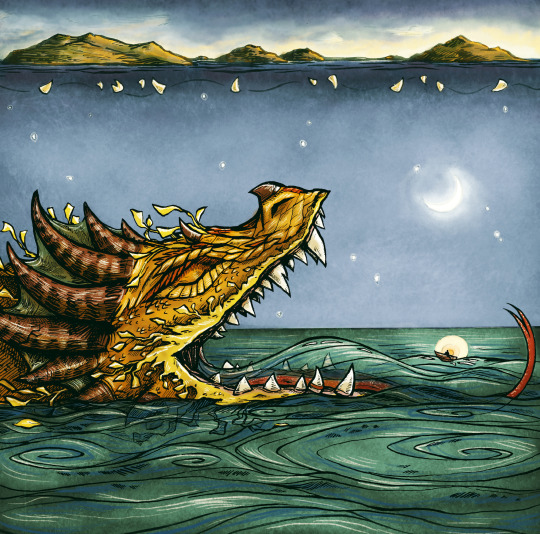
The Mester Stove Worm [Orcadian/Scottish mythology]
Have you ever wondered why Iceland has such active volcanoes? According to an old Orcadian legend, that is because the burning carcass of a giant dragon lies buried beneath it.
Stove worms were giant dragon-like creatures that lived in the ocean, according to Orcadian folktales. Whereas Dennison referred to these creatures as ‘stove worms’ I find that all later sources call them ‘stoor worms’ and I wonder where that difference came from. Nevertheless, the Mester Stove Worm (‘mester’ simply meaning ‘master’) was the biggest and most dangerous of them all. Colossal and vile, the creature was referred to as the most terrible out of all the animals in the world. It was thousands upon thousands of miles long, and had a giant forked tongue that reached several hundreds of miles in length. With this tongue, it swept entire villages into the sea. In addition, the creature could poison the land with its noxious breath, which brought pestilence upon the people and blighted crops. The monster was not born via natural means, but was brought into being by mysterious and malicious spirits.
It was eventually slain in the tale of Assipattle, a local folk character. The story is so stereotypical of fairy tales and common tropes (the hero slays the dragon with trickery rather than strength, and gets to marry the beautiful princess he saved as a reward) that I originally assumed it was a modern story. Keep in mind though, that I found no sources predating Dennison’s 1891 retelling of Orcadian mythology, and he cited no source himself, instead claiming that the story was told to him as a child.
Regardless, the story goes like this:
When the Mester Stove Worm appeared near the coast, the people had to bring it an offering of seven virgin maidens every week. If they failed to do so, the monster would blight the land. Although the offerings prevented the monster from destroying them all, it was not a sustainable solution, for eventually the land would run out of fair maidens. So the people sought the council of an old learned wizard. The mage was a prophet and foresaw that if the king’s daughter was fed to the dragon, it would leave and not return. The king reluctantly agreed, for although she was his only child, he had to save his country. But he asked for 10 weeks of respite, during which he sent out messengers to other countries with the promise that if a hero managed to slay the monster, he would be wed to the princess as a reward.
No one took the offer, because no man dared to fight the humongous creature. But Assipattle, the hero of the story and a poor peasant boy stood up against the worm on the final day. He steered his boat right into the gaping maw of the creature, and ventured into the bowels of the monster, carrying a kettle with peat. Eventually he made his way to the creature’s liver and set fire to it with his burning peat, for indeed the liver was full of oil and instantly caught fire.
After escaping the monster, Assipattle witnessed the colossal creature convulsing in agony. Its death spasms were a sight to behold as the monster slashed with its colossal tongue, reaching all the way to the moon, and eventually made a deep slit into the ground with its tongue. This gap filled up with water and is now the gulf that separates Denmark from the other Scandinavian countries.
Still convulsing in pain, the dragon shed its huge teeth. They fell into the sea and became the Orkney islands. Then, it threw its giant head into the sky and came down, again shedding some teeth. They became the Shetland islands. After shedding teeth for the third time, the Faroe islands were formed.
Finally, the Mester Stove Worm coiled up and died. Its corpse became the island of Iceland, and the huge conflagration in the creature’s liver is still burning deep beneath the surface of that land, which is why there are so many active volcanoes in Iceland.
Modern retellings of the story add elements that showcase the hero as a trickster: he stole the king’s boat by tricking the guard, he stole his father’s horse with a similar trick, etc. I do not know how old these subplots are or when they were added to the story, so they might not be modern additions at all.
Sources:
Dennison, T. W., 1891, Orkney Folklore: Sea myths, in Scottish Antiquary: or Northern Notes & Queries, Edinburgh University Press, 5:19, 130-133.
Forrester, K., 2016, Celtic Tales: Fairy Tales and Stories of Enchantment from Ireland, Scotland, Brittany and Wales.
(image source 1: Bo Myles on Artstation)
(image source 2: folklorescotland.com)
#Orcadian mythology#Scottish mythology#dragons#sea monsters#aquatic creatures#monsters#mythical creatures#mythology#myths
72 notes
·
View notes
Text

Fear, for it is the demon from the sea. The Nuckelavee rises from the ocean to terrorize the shore of Orkney, its breath carrying disease for humans and animals alike, wilting crops, and bringing drought.
#BriefBestiary#bestiary#digital art#fantasy#folklore#legend#myth#mythology#orcadian folklore#orcadian mythology#sea fairy#sea demon#demon#drought monster#nuckelavee#knoggelvi#nuckalavee#orkney#monster
11 notes
·
View notes
Text
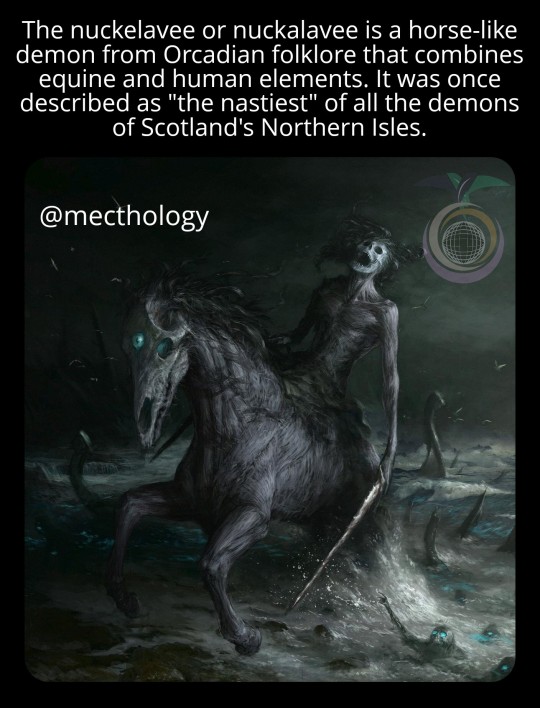
Nuckelavee from Orcadian folklore.
The Nuckelavee was a creature of abject terror and spoken of with bated breath.
The Nuckelavee was a creature of sheer evil. His sole purpose was to plague the islanders - a task from which he rarely rested. The nuckelavee's breath was thought to wilt crops and sicken livestock, and the creature was held responsible for droughts and epidemics on land despite being predominantly a sea-dweller.
In common with many other sea-monsters, it is unable to tolerate fresh water, therefore, those it is pursuing have only to cross a river or stream to be rid of it. The nuckelavee is kept in confinement during the summer months by the Mither o' the Sea, an ancient Orcadian spirit, and the only one able to control it.
A unique and solitary creature possessing extensive evil powers, its malevolent behaviour can influence events throughout the islands. Islanders were terrified of the creature and would not speak its name without immediately saying a prayer. It was often found in the vicinity of a beach but would never come ashore if it was raining.
No tales describe what form the nuckelavee takes when in the sea, but its appearance on land has been recounted in graphic detail. An islander, Tammas, claimed to have survived a confrontation with the beast, and according to him, the nuckelavee has a man's torso attached to a horse's back as if it were a rider. The male torso has no legs, but its arms can reach the ground from its position on top of the equine body, the legs of which have fin like appendages. The torso has a large head – possibly as much as 3 feet (90 centimetres) in diameter – that rolls back and forth. The monster described by Tammas has two heads; the equine head has an enormous gaping mouth that exudes a pungent, toxic vapour and a single giant eye like a burning red flame. A particularly gruesome detail is that the nuckelavee has no skin; black blood courses through yellow veins, and the pale sinews and powerful muscles are visible as a pulsating mass.
Follow @mecthology for more myths and lore.
DM for pic credit or removal.
Source: Wikipedia and orkneyjar.com
#mecthology#mythology#supernatural#creepy#mitoloji#orcadian#folktale#folklore#evil#malevolent#monster
17 notes
·
View notes
Text
GREAT BRITAIN & WEST EUROPEAN RESOURCES
The Anthropological Masterlist is HERE.
Great Britain is a European island in the North Atlantic Ocean. It is the largest island in the world.
ARTHURIAN ─ “The Matter of Britain, or the Arthurian cycle, is a medieval European body of literature.”
─ Arthurian Information
─ Arthurian Sources
─ Arthurian Texts
CORNWALL ─ “The Cornish people are a Western European people. They are native to Cornwall.”
─ Cornwall’s Stones
─ Cornish History
─ Cornish Dictionary
ENGLAND ─ “The English people are a Germanic people. They are native to England.”
─ Middle English Literature
─ English Folklore
─ The English Renaissance
ICENI ─ “The Iceni, or Ecini, were a Brittonic people that lived from the British Iron Age to the early Roman era. They lived in modern-day Norfolk.”
─ Iceni Information
IRELAND ─ “The Irish people are a Western European people that share the Irish culture. They are native to Ireland.”
─ Irish Folklore & Mythology
─ Irish History
─ Irish Language
MANX ─ “The Manx people are a West European people that share the Manx culture. They are native to the Isle of Man.”
─ Manx Information
─ Manx History
─ Manx Language
ORKNEY ─ “Orkney, or the Orkney Islands, is a European archipelago. It is located in Scotland.”
─ Orcadian Information
─ Orcadian Culture & History
SCOTLAND ─ “The Scottish, or Scotch, people are a European people. They are native to Scotland.”
─ Scottish Folklore
─ Scottish History
─ Scots Language
WALES ─ “Welsh people are a Western European people that share the Welsh culture. They are native to Wales.”
─ Welsh Culture
─ Welsh History
─ The Four Branches of the Mabinogi
Western Europe is a European region that constitutes the western part of the European continent. Great Britain is also considered part of Western Europe.
BELGIUM ─ “The Belgian people are a Western European people that share the Belgian culture. They are native to Belgium.”
─ Belgian History
─ Belgian Timeline
DUTCH ─ “The Dutch people are a West Germanic people. They are native to the Netherlands.”
─ Dutch Literature (in Dutch)
─ Dutch Folklore
─ Dutch History
FRANCE ─ “The French people are a Western European people that share the French culture. They are native to France.”
─ French Culture
─ French History
─ French Dictionary
FRANKS ─ “The Franks were a Germanic people. They lived between the Lower Rhine and Ems River.”
─ Frankish Information
─ Frankish Information
─ Rise of the Franks
GERMANIC NEOPAGANISM ─ “Germanic Neopaganism, or Heathenry, is a Pagan religion. It originated in Europe in the early 20th century C.E.”
─ Germanic Neopagan Information (in German)
*MEDIEVAL EUROPEAN ─ “The Middle Ages, or the Medieval Period, was a European period of time from the 5th century C.E. to the 15th century C.E.”
─ Medieval Culture
─ Pliny’s History of the World
─ Medieval Military History
NORSE ─ “The Nordic, or North Germanic, people are a Germanic people. They are native to the Nordic region of Europe.”
─ Vikings of Denmark
─ Norse Mythology
─ The Edda
SWEDEN ─ “The Swedish, or Swede, people are a Germanic people. They are native to Sweden.”
─ Swedish Culture
─ Swedish History
─ Swedish Dictionary
* - The Medieval European period was not just a Western European period of time. It was also part of many other European histories.
#resources#great britain#west europe#arthurian#cornwall#england#iceni#ireland#manx#orkney#scotland#wales#belgium#dutch#france#franks#germanic neopaganism#medieval european#norse#sweden
164 notes
·
View notes
Text
Round One Brackets

Welcome to round one! In total, we have 116 characters competing for the title of Best Monster! Voting will start June 26th. Good luck!
(Special shout out to my friends for helping, thanks guys!)
PART ONE
Ken Kaneki (Tokyo Ghoul) VS Power (Chainsaw Man) Denji (Chainsaw Man) VS Tony Tony Chopper (One Piece) Koro-Sensei (Assassination Classroom) VS Garou (One Punch Man) Kumoko (So I'm a Spider So What) VS Byakuroku (Amatsuki) Imperfect Cell (Dragon Ball Z) VS Dio Brando (JoJo's Bizarre Adventure) "Hikaru" (The Summer Hikaru Died) VS Shin-ah (Akatsuki no Yona) Moerumba (Futari wa Precure Splash Star) VS Sparda (Mahoutsukai Precure) Shindoine (Healin' Good Precure) VS John Doe (Yumekui Merry) Envy (Fullmetal Alchemist) VS Migi (Parasyte)
PART TWO
Frankie Stein (Monster High G1) VS Frankie Stein (Monster High G3) Draculaura (Monster High G1) VS Clawdeen Wolf (Monster High G1) Lagoona Blue (Monster High G1) VS Cleo de Nile (Monster High G1) Ghoulia Yelps (Monster High G1) VS Abbey Bominable (Monster High G1) Twyla (Monster High G1) VS Robecca Steam (Monster High G1) Spectra Vondergeist (Monster High G1) VS Operetta (Monster High G1) Deuce Gorgon (Monster High G1) VS Clawd Wolf (Monster High G1) Seth Ptolemy (Monster High G1) VS Jackson Jekyll/Holt Hyde (Monster High G1) Catty Noir (Monster High G1) VS Scarah Screams (Monster High G1)
PART THREE
Frankenstein's Monster (Frankenstein) VS Dracula (Dracula) Godzilla (Godzilla) VS King Kong (King Kong) Grendel (Beowulf) VS Gremlin (Gremlins) Mothra (Mothra) VS Minotaur (Greek Mythology) Baba Yaga (Slavic Folklore) VS El Coco (Folklore) Bigfoot (Folklore) VS Mothman (Folklore) The Wolfman (The Wolfman 1941) VS The Mummy (The Mummy 1959) Nosferatu (Nosferatu) VS Carmilla (Carmilla)
PART FOUR
Kelpie (Scottish Folklore) VS Nuckelavee (Orcadian Folklore) Santa Claus (Christian Mythology) VS Krampus (German Folklore) The Creature from the Black Lagoon (The Creature from the Black Lagoon 1954) VS Audrey II (Little Shop of Horrors) Shrek (Shrek) VS The Grinch (Dr. Seuss' How the Grinch Stole Christmas) Elmo (Sesame Street) VS Venom (Marvel) Mike and Sully (Monsters Inc) VS Bowser (Mario Games) Monster House (Monster House) VS Giggling Green Ghost (Scooby-Doo) Edalyn Clawthorne (The Owl House) VS Vee Noceda (The Owl House)
PART FIVE
Springtrap (Five Nights At Freddy's) VS Sans (Undertale) Oz (Monster Prom) VS Polly Geist (Monster Prom) Faust (Guilty Gear Strive) VS Tenebrae (Tales of Symphonia: Dawn of the New World) Reese Kelly (Scarlet Hollow) VS Zoe (Monster Prom) Chaos (Sonic Adventures) VS Teddie (Persona 4) Alucard (Castlevania) VS Ludwig the Holy Blade (Bloodborne) Asterius (Hades) VS Phonegingi (Dialtown) Lord Raptor (Darkstalkers) VS Firebrand (Ghosts 'n Goblins)
PART SIX
Mimikyu (Pokémon) VS Wormmon (Digimon) Impmon (Digimon) VS Guilmon (Digimon) Pikachu (Pokémon) VS Tyson (Percy Jackson) Lorgar Aurelian (Warhammer 40k) VS Rykard (Elden Ring) Mr. Hyde/Brain (Arthur) VS Twerkey (Miitopia) Micheal (The Magnus Archives) VS Jonathan Sims (The Magnus Archives) Elias Bouchard (The Magnus Archives) VS John Doe (Malevolent) The Hound (RWBY) VS Falin Touden (Dungeon Meshi)
PART SEVEN
Ankh (Kamen Rider OOO) VS Momotaros (Kamen Rider Den O) Graphite (Kamen Rider Ex Aid) VS Hajime Aikawa (Kamen Rider Blade) Urataros (Kamen Rider Den O) VS Kintaros (Kamen Rider Den O) Ryutaros (Kamen Rider Den O) VS Sieg (Kamen Rider Den O) Deneb (Kamen Rider Den O) VS Teddy (Kamen Rider Den O) Gubila (Ultraman) VS Pigmon (Ultraman) Nowhere King (Centaurworld) VS Pega (Ultraman Geed) Reimon (Ultra Galaxy: Mega Monster Battle) VS Kate (Ultra Galaxy: Mega Monster Battle)
23 notes
·
View notes
Text
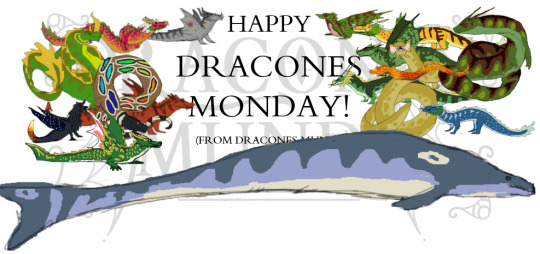
Happy Dracones Monday!
Today's dragon is the stoorwyrm or Atlantic Sea Dragon! I'm really happy with the pattern on this doodled design, but not 100% on board with the body shape - despite researching marine reptiles as a job I'm abysmal at making up fictional ones. I could make my crocodile-dragons evolve into animals similar to thalattosuchians (marine crocodile-relatives of the Mesozoic) but I feel going for a more fantastical whale-serpent would fit the mythology better.
This said, whales swim with up-down undulations whereas a marine reptile would swim with side-to-side undulations, so I may end up pushing a more serpentine or aguiliform shape instead of a whale shape...
The name 'stoorwyrm' comes from the Orcadian legend of Mester Stoorwurm, a sea serpent that was menacing Orkney until someone rowed their boat full of explosives into the dragon's mouth, kaboom!
For more dragons, follow @draconesmundi
17 notes
·
View notes
Photo




Some Nuckelavee sketches, a few with a claymore :3 Nuckelavee is a freaky person/horse demon from Orcadian mythology with breath so bad it can destroy your crops and make you+your livestock sick. It chills in the sea around Scotland's Northern Isles
4 notes
·
View notes
Photo
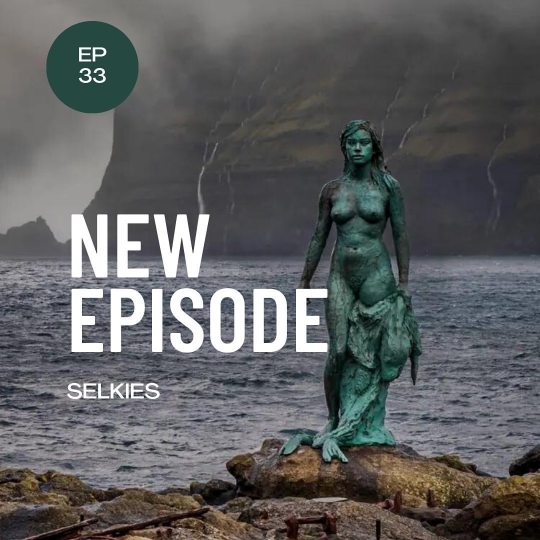
Our new episode is live wherever you listen to podcasts! We’re back to folklore with a wee chat about the Orcadian mythology of selkies 🦭 #podcast #scotland (at Scotland) https://www.instagram.com/p/CnjLCJKs2fY/?igshid=NGJjMDIxMWI=
0 notes
Text
Couldn't sleep so here's a nuckelavee sketch
¯\ _(ツ)_/¯
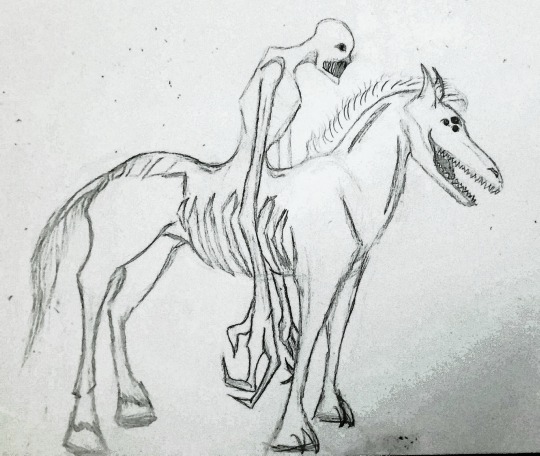
4 notes
·
View notes
Photo

The Sea Mither [Orcadian mythology; Scottish mythology]
Orcadian legends tell of a powerful and benevolent water spirit who resides in the seas. It is said that every living thing in the oceans was given life by this spirit. She has no given name, instead she is called “the Mither of the Sea” or simply “the Sea Mither”. Although powerful, this spirit was locked in a constant rivalry with another powerful spirit of nature. He was named Teran, which means “anger” or “rage” in an old Orkney dialect. In the middle of spring of each year, a great battle is waged between these two ancient spirits, and this fight can last multiple weeks. This was a way to explain the large storms that arise around that time.
Teran always loses this fight, and is then captured by the Sea Mither and imprisoned at the bottom of the ocean. When a particularly powerful storm appeared, it was said that this was caused by Teran’s struggles to free himself. Eventually, in the middle of autumn, the autumnal equinox arrives. The Sea Mither is tired from managing the seas, keeping the waves calm, and guarding her prisoner. Every year at this point, Teran breaks free and battles his opponent, and multiple storms ensue. And every year, he defeats her and drives her from the oceans, only for her to return and defeat him during the next vernal equinox.
Locked in this constant struggle, the Sea Mither only spends half of each year in the ocean. But when she does, she also imprisons the Nuckelavee – a powerful and horrible monster that roams and blights the land when it isn’t captured by the sea spirit. Sometimes, the Sea Mither is equated to an Orcadian version of the ‘Mother Nature’ concept.
Source:
Dennison, T. W., 1890, Orkney Folklore: Sea myths, in Scottish Antiquary: or Northern Notes & Queries, Edinburgh University Press, 5:18, 68-71.
Pérez-Lloréns et al., 2020, Seaweeds in mythology, folklore, poetry and life, Journal of Applied Phycology, 32, 3157-3182.
(image source: “the mother of the sea” by Fei Geng on Artstation)
#Orcadian mythology#Scottish mythology#Celtic mythology#mythical creatures#spirits#water spirits#mythology#myths
52 notes
·
View notes
Text

The Northern Lights are formed by their deadly warring, staining the sky with both glimmering and graceful dance and pooling lifeblood.
#BriefBestiary#bestiary#digital art#fantasy#folklore#legend#myth#mythology#na fir-chlis#mirrie dancers#merry dancers#nimble men#fae#fairy#fallen angel#orcadian folklore#orcadian legend
15 notes
·
View notes
Photo

Nuckelavee
#artists on tumblr#Nuckelavee#nuckalavee#equine#mythology#orcadian mythology#demon#demonology#water#ocean#storm#clouds#horse#anatomy#horseman#folklore#norse mythology#celtic mythology#implied drowning tw#implied death tw
9 notes
·
View notes
Link
A Nuckelavee, a nasty demon from Orcadian myth.
0 notes
Text
Oh, I've mistaken that deer centaur sculpture for Nuckelavee, who is much more terrifying
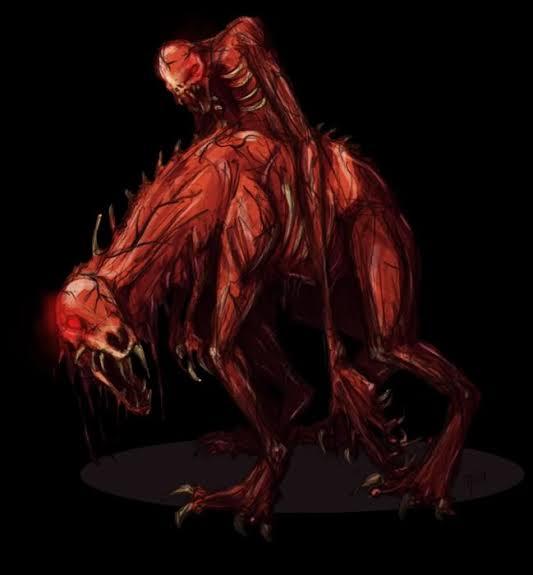



#easily one of the most disturbing mythological beings#Nuckelavee#body horror#gore#mythology#NOT IRISH. ORCADIAN
84 notes
·
View notes
Photo

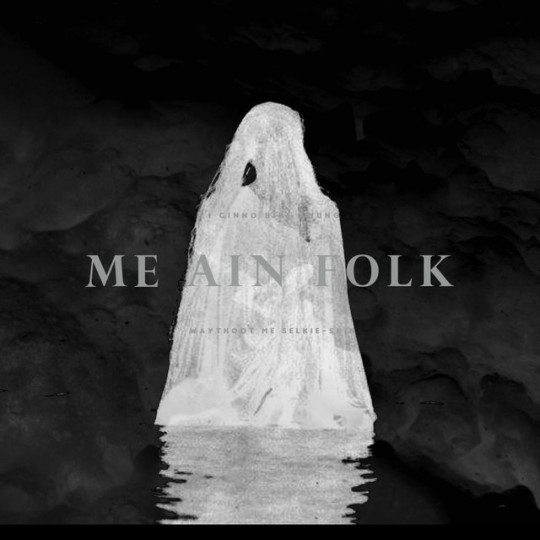
ORCADIAN MYTHOLOGY: Selkies
A common element in all the selkie-folk tales, is that in order to shapeshift they had to cast off their sealskins. Within these magical skins lay the power to return to seal form, and therefore the sea.If this sealskin was lost, or stolen, the creature was doomed to remain in human form until it could be recovered. Because of this, if disturbed while on shore, the selkie-folk would hastily snatch up their skins before rushing back to the safety of the sea. (x)
#mythedit#mythologyedit#orcadian mythology#scottish mythology#selkie#selkies#mythology#orkney#my edits#my posts#fyeahmyths#hi i love selkies#and i'm probably gonna do edits for all my local myths
501 notes
·
View notes
Photo

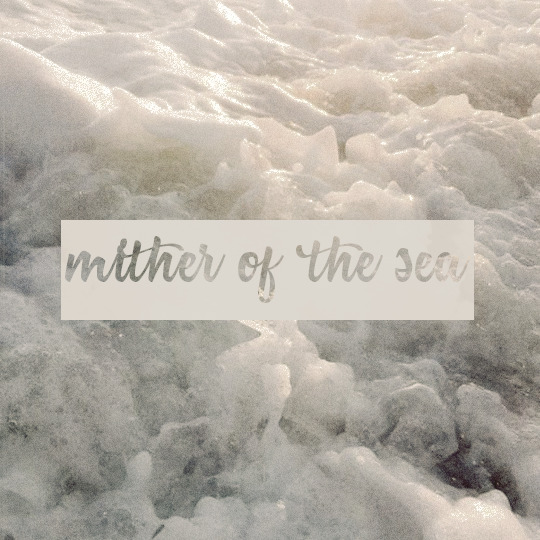
Sea Mither, a mythical creature that lives in the sea during the summer when she confines the demonic nuckelavee to the ocean depths.
179 notes
·
View notes